
What a Great Gig with Lowlands in Milan
I performed last night (5 April 2014) with Lowlands in Milan, and it was a great gig. The venue, Spazio Teatro 89, is a very nice theatre that seats about 250, and the place was packed. The acoustics in the room and onstage were wonderful. I could hear every detail of my own and the band’s performance without straining. The band—which actually consisted of a core unit of Ed Abbiatti (guitarist, vocalist, and songwriter), a keyboardist (on piano, organ, and accordion), a drummer, a mandolinist, augmented by a range of performers (including me, a cellist, a horn section, a lap steel guitarist, and two bassists, one standup, one electric) who played on some tunes but not all (I played on 17 tunes, which shows you how long the set was)—was in fine form, and the audience went nuts basically from the first piece through the end of the show. Very cool.
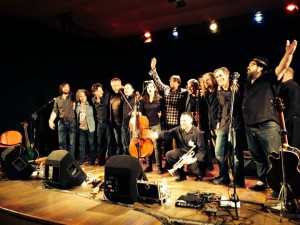
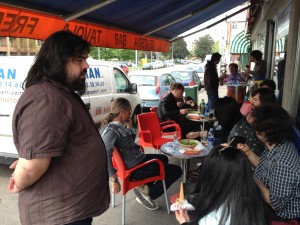
Like Bob Dylan’s, Ed’s music is simple but not simplistic. The song structures include subtle turns and changes; the measures usually add up to 4/4, but they might be structured as a 2+6 instead of the 4+4 that you’d expect. Ed’s lyrics are often dark, but he’s not afraid of beauty, and there were a lot of moments in this show that were frankly beautiful in ways that most rockers wouldn’t dare to try. Rockers mostly like it tough, tough, tough, and I think many of them are scared that they’ll look soft if they openly embrace beauty. (Sting is the exception to the rule among the top tier; maybe he’s consciously using the beauty as emotional counterpoint to his anything-but-sentimental lyrics.) Ed doesn’t have that hangup, and I reveled all night long in the sheer gorgeousness of the sound, especially in the first half of the show, when I was paired with the core band of acoustic guitars, mandolin, keys, drums, and acoustic bass, a setup that gave me lots of freedom to contribute lines and colors.

Two Chains Running
I used a setup for this gig that included two mic chains. The gig was billed as an “unplugged†show, but Ed read my blog post about using the Digitech RP360, and he let me carry it onstage. (Phew.) I brought my Radial Tonebone ABY box to the show, and it’s a little-known fact that while this device is designed to send one input to either or both of two outputs, you can also turn it around and use it to switch between two inputs with a single output. That’s what I did here; I set it up to take one input from the house-supplied mic, an Electro-Voice Raven dynamic (about which more later), and one from the Digitech RP360 with input from my Audix Fireball. The ¼†output from the ABY box went to my own passive direct box, and from there to the main board via XLR cable. I had to supply a lo-z to hi-z transformer for the house mic cable to get it to work with the Radial ABY box, but I carry at least two such transformers with me to every gig, so no problem there. Take a look at the picture below to see what the chain looked like on the floor. (And take a look at the photo of the bass player’s pedalboard to see how simple my rig is by comparison, even with two mics.)
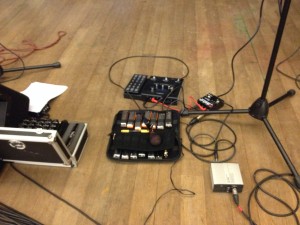
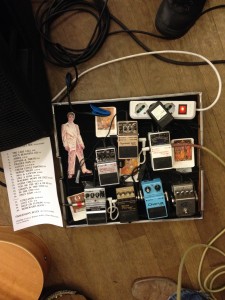
You learn a lot by doing side-by-side comparisons, and what I learned on this gig was that I need to do more work on the RP360 patches that I’ve set up for “acoustic†tones. My current clean patch setups on the 360 use a Clean 2101 preamp model with a fair amount of gain plus EQ settings that are designed to take out a lot of high-frequency content (because harp is not short on high frequencies, and it can get pretty zingy out there when they’re amped). It’s a very nice sound, but it’s also a big, wide, mid-rangy sound that came off as “ampy,†not acoustic, in comparison to the Raven mic. The Raven had a beautiful, crystal-clear but warm sound that I couldn’t match with any of my RP360 setups, and I didn’t really want to hold up the sound check while I programmed and tested changes in the 360 setup, so the best solution was to use the two-mic setup with the ABY box. (I’ll have to do something about the RP360 setup when I get a chance.)
Of course, some of the difference in sound probably was the result of hand-holding the Audix mic that fed the 360; when you hold the mic in your hand, the hand absorbs some of the high frequencies. That was just more reason not to try to duplicate what I was hearing from the stand-mounted Raven.
Simple, Effective Changes in Performance
I used the footswitch on the ABY to choose between mics on a song-by-song basis. To keep things extra simple, I restricted myself to one mic per song, and to one sound from the RP360 when that was the selected chain. (It’s not wise to complicate your setup choreography when you’re already trying to stay in sync with a band that you met for the first time 6 hours before the show.) This was easy enough to manage in performance, though we did we have one freakout moment before the show when I accidentally reset the input switch on the direct box from “instrument†to “speaker†(the latter of which is appropriate when you’re using the direct box between an amp and a recording device), which effectively killed the output from the Raven mic and clouded up the output from the 360. Fortunately, we got it sorted before the show started, and once we had the audience in front of us, everything worked fine.
The show began with Ed’s song “The Last Call,†which is about death, and I used my MA_4D patch from the v16 and v17 Huntersounds RP patchsets, which has a Matchless Chieftain amp model enhanced with a pitch shifter that adds a perfect 4th down to the original pitch. It’s a deadly, otherworldly sound, especially in minor keys. I played a CX12 chromatic, which bends more deeply and easily than any other chromatic in my kit, on this song and on two other pieces; the rest of the time I used various diatonics, including a Lee Oskar natural minor in A, a Seydel 1847 in Eb that is the most responsive harp in my kit, a Suzuki Manji in E, and a pair of Seydel Session Steels in A and C respectively. (Like most singers, Ed prefers certain keys above others, which means that I needed to rely on a small set of harps.) The only other RP360 sound I used on this gig was my Huntersounds v17 GA40 patch, which pairs a Gibson GA40 amp model with a GA40 cabinet model. (And that’s why we call it “GA40,†as opposed to “Amped Up and Raw,†which is an equally accurate name.) On one tune I played the first two forms on the CX12 (in the key of E), then switched to the E Manji in first position to close it out. Charlie Musselwhite does that kind of thing a lot; the subtle changes in tone you get that way help to add some juice to a tune, and in this case it allowed me to go from a single-note approach to some very sweet chords.
The setups and instruments did the job. I felt utterly confident in my sound all night long, enough to take some big chances in my solos. At various points I augmented the horn section with harp, playing their lines on both chromatic and diatonic, and I was able to match their dynamics without strain. The saxophonist who led the horn section went out of his way to tell me how much he enjoyed playing with the harp that night. (Most musicians have very low expectations of the harmonica, based on the less-than-stellar players they’ve already encountered, so they’re blown away the first time they hear you play a single note clearly with a controlled volume ramp. Before the show, you have to be patient with them, keeping in mind that they need to hear you play before they can get over whatever first impressions they got from the usual lot. Alas.)
About that Raven
For most of the show, I used the Raven mic straight to the board, and I loved the clarity, beauty, and detail in the sound. The Raven is a very moderately priced dynamic mic that acts like a condenser, with a fairly low proximity effect. Because it’s a dynamic, it doesn’t need phantom power, which is a plus for setup onstage. It’s directional enough to exclude sounds from the sides, but not so directional that the sound changes dramatically when the angle of the instrument to the mic changes slightly. It’s no longer in production but available used, and it may very well be the next addition to my mic locker. I wouldn’t use it as a handheld, which would make it less suitable for recording in crappy-sounding rooms like the ones where I do a lot of recording (e.g., in a hotel room or my kitchen), but for acoustic live shows I think it’s da bomb, especially since I can pair it with my electric rig so easily and give the soundman a single feed to the board, which is very nice when inputs are in short supply. It’s also a pretty cool-looking mic; see the photo below. That tear-droppish shape is familiar and dear to harp players, of course, but I think anybody would find it to be a very cute piece of kit.
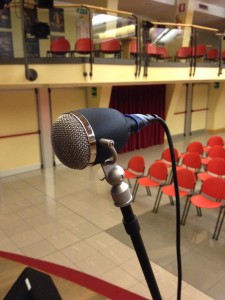
Coming Soon to a DVD Player Near You
This show was professionally recorded to video and audio, and the audio recording setup was a full-blown Pro Tools HD rig with more than enough inputs for every instrument on the stage. When I wasn’t playing, I hung out backstage observing the recording, and the levels looked good. I have no doubt that the show will look and sound good when it’s all mixed and mastered, and I can’t wait to tell everyone where to get the DVD. So stay tuned for news on where to find it. In the meantime, I’m still buzzing from one of the most enjoyable gigs I’ve ever played.
Related Posts
Leave a Reply
You must be logged in to post a comment.
WHAT’S NEW
Categories
- Audio/Video
- Blog
- Blue Future
- Digitech RP Tricks and Tips
- Discography, CDs, Projects, Info, Notes
- Featured Video
- For the Beginner
- Gallery
- Hunter's Effects
- Hunter's Music
- Huntersounds for Fender Mustang
- Meet the Pros
- More Video
- MPH: Maw/Preston/Hunter
- My Three Big Contributions
- Player's Resources
- Pro Tips & Techniques
- Recommended Artists & Recordings
- Recommended Gear
- Recorded Performances
- Reviews, Interviews, Testimonials
- The Lucky One
- Uncategorized
- Upcoming Performances
- Zoom G3 Tips and Tricks
